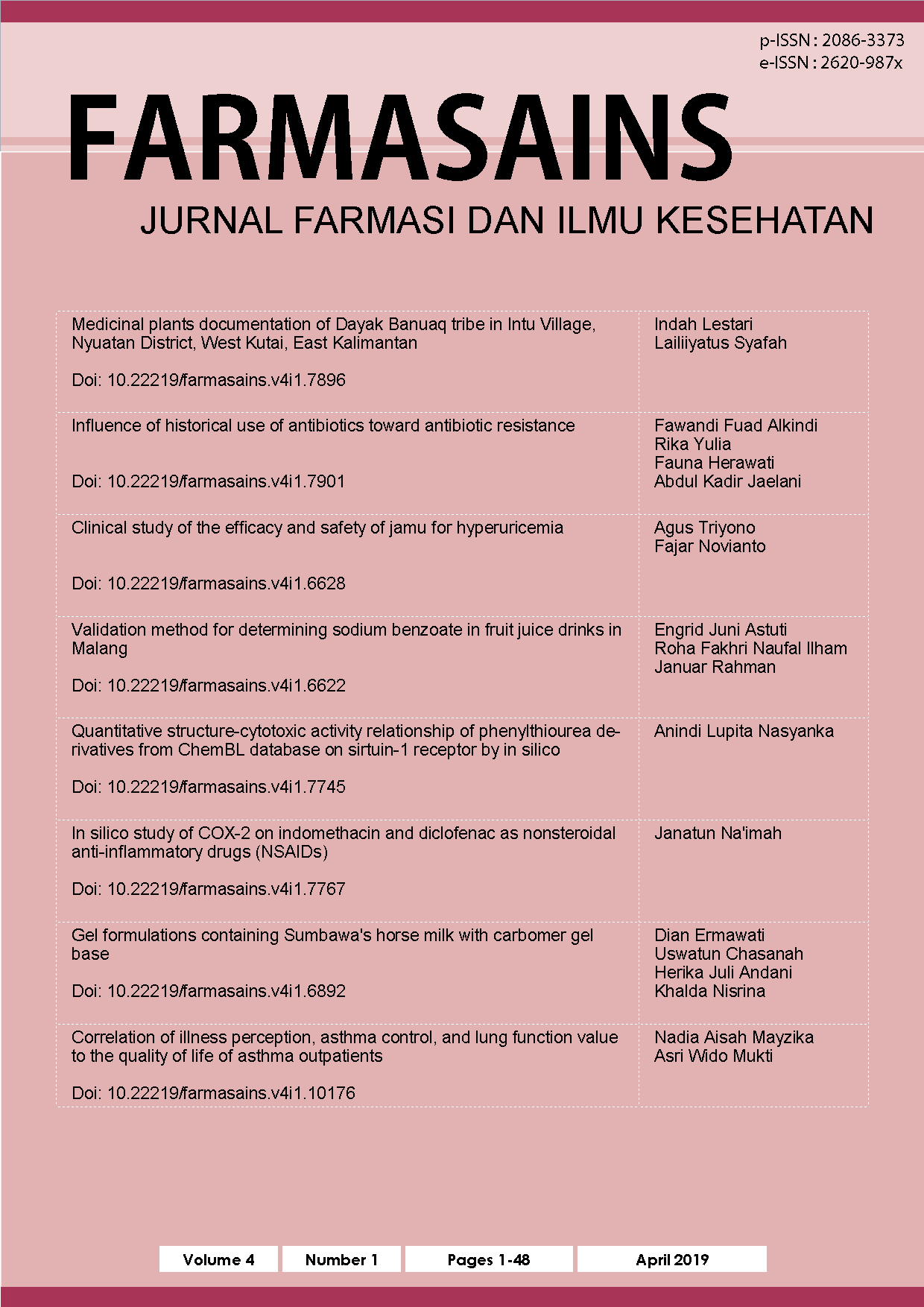Clinical study of the efficacy and safety of jamu for hyperuricemia
DOI:
https://doi.org/10.22219/farmasains.v4i1.6628Keywords:
Clinical research, Jamu, HyperuricemiaAbstract
Hyperuricemia is a degenerative disease with a reasonably high prevalence and requires long-term treatment. Clinical research has been conducted to test the efficacy and safety of herbal medicine for hyperuricemia. The research involved 30 subjects who had fulfilled the inclusion and exclusion criteria and conducted with a pre-post test research design. Subjects were treated with herbal medicine for hyperuricemia three times a day for 28 days. From the research, jamu for hyperuricemia was effective in reducing blood uric acid levels from 7.43 mg/dL to 5.72 mg/dL, raising the quality of life score (SF-36) from 78.06 to 81.50, and disappeared of clinical symptoms. Use of herbal medicine for hyperuricemia for 28 days in subjects had no symptoms of severe side effects found and did not interfere with liver, kidney, and blood function.Downloads
References
Afifah, E. & Lentera, T. (2003). Khasiat & manfaat temulawak: rimpang penyembuh aneka penyakit. Jakarta, Indonesia: Agromedia.
Anggraeni, R. A. (2013). Uji Aktivitas Antihiperurisemia Ekstrak N-Heksana, Etil Asetat Dan Etanol 70% Daun Kepel [Stelechocarpus Burahol (Bi.) Hook. F. & Th.] Pada Mencit Putih Jantan Hiperurisemia. (Undergraduate thesis, Universitas Jember, Jember, Indonesia). Retrieved from http://repository.unej.ac.id/handle/123456789/2563.
Cendrianti, F., Muslichah, S., & Ulfa, E. U. (2014). Uji Aktivitas Antihiperurisemia Ekstrak n-Heksana, Etil Asetat, dan Etanol 70% Daun Tempuyung (Sonchus arvensis L.) pada Mencit Jantan Hiperurisemia. Pustaka Kesehatan, 2(2), 205-210.
Kementrian Kesehatan. (2010). Peraturan Menteri Kesehatan Republik Indonesia Nomor: 003/MENKES/PER/I/2010 tentang Saintifikasi Jamu dalam Penelitian Berbasis Pelayanan Kesehatan. Jakarta, Indonesia: Author.
Lamb, E., Newman, J, D., & Price, P, C. (2006). Kidney Function Test In C. Burtis., E. Ashwood & D. Bruns (Eds.), Tietz Textbook of Clinical Chemistry and Molecular Diagnostic 4th edition (pp. 803-805). Philadelphia, PA: Elseiver Saunders.
McGilvery, R. W., & Golstein, G. W. (1996). Biokimia Suatu Pendekatan Fungsional Edisi Ketiga. Surabaya, Indonesia: Airlangga University Press
Nurwanto, A. H. (2013). Efek Analgesik Dekok Rimpang Kunyit (Curcuma Domestica Val.) Pada Tikus Putih Strain Wistar Dengan Metode Paw Pressure Test. (Doctoral dissertation, University of Muhammadiyah Malang, Malang, Indonesia). Retrieved from http://eprints.umm.ac.id/28423.
Pertamawati & Hardhiyuna M. (2015). Uji Penghambatan Aktivitas Enzim Xantin Oksidase Terhadap Ekstrak Kulit Kayu Secang (Caesalpinia sappan L.). Kartika : Jurnal Ilmiah Farmasi, 3(2), 12-17.
Singh, V., Gomez, V, V., & Swamy, S, G. (2010). Approach to a Case of Hyperuricemia. Indian Journal of Aerospace Medicine, 54(1), 40-45.
Soenarta & Arieska. (2005). Konsensus pengobatan hiperurisemia. Jakarta, Indonesia: Perhimpunan Hiperurisemia Indonesia.
Sudoyo, A. W. (2006). Buku Ajar Ilmu Penyakit Dalam Jilid II Edisi IV. Jakarta, Indonesia: Departemen Ilmu Penyakit Dalam FKUI.
Winarno, M. W., Widowati, L., & Sundari, D. (2015). Studi keamanan ramuan jamu untuk hiperurisemia dan hipertensi. Buletin Penelitian Kesehatan, 43(3), 137-146.
Downloads
Published
How to Cite
Issue
Section
License
Copyright (c) 2019 Agus Triyono, Fajar Novianto

This work is licensed under a Creative Commons Attribution 4.0 International License.
Authors who publish with this journal agree to the following terms:
a. Authors retain copyright and grant the journal right of first publication with the work simultaneously licensed under a Creative Commons Attribution License that allows others to share the work with an acknowledgement of the work's authorship and initial publication in this journal.
b. Authors are able to enter into separate, additional contractual arrangements for the non-exclusive distribution of the journal's published version of the work (e.g., post it to an institutional repository or publish it in a book), with an acknowledgement of its initial publication in this journal.
c. Authors are permitted and encouraged to post their work online (e.g., in institutional repositories or on their website) prior to and during the submission process, as it can lead to productive exchanges, as well as earlier and greater citation of published work (See The Effect of Open Access).













